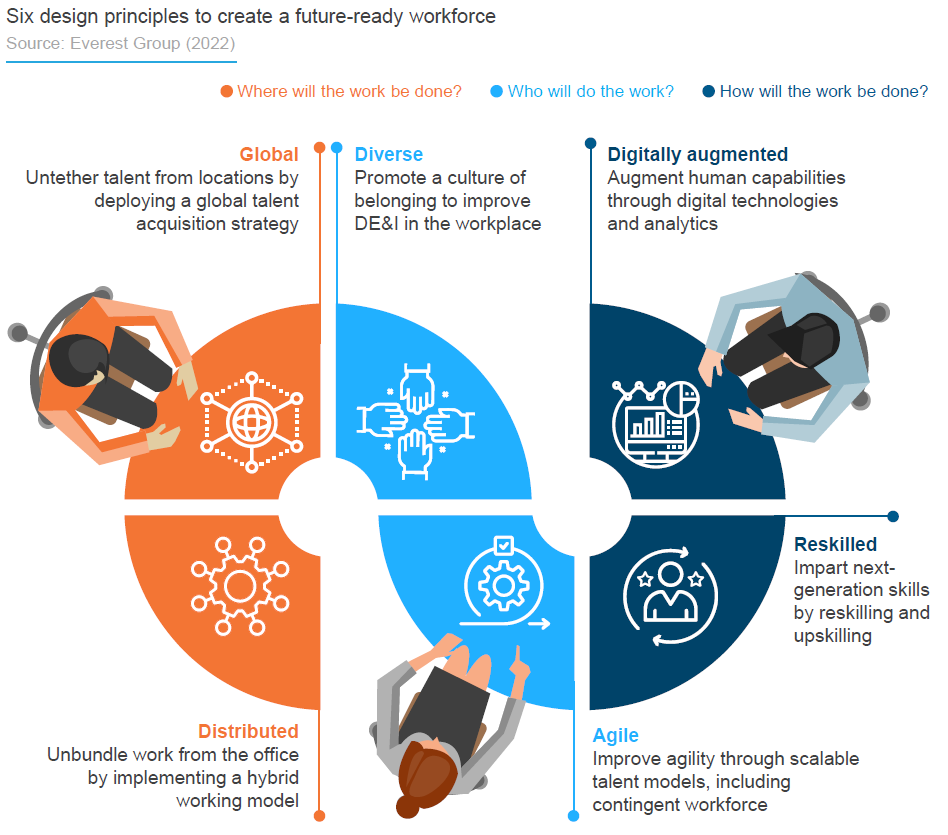Select a Country Site
Changing your site will take you to the URL for that ManpowerGroup location.

The study uses existing intellectual property and data from a survey of 200 senior HR leaders from various regions, industries, and organizations. The report looks at three primary concerns impacting the workforce and workplace mechanics:
1. Where will the work be done?
2. Who will do the work?
3. How will the work be done?
The research provides practical advice to HR leaders and organizations on navigating the next normal for their organizations. It shows how important it is to use flexible and adaptable workforce models, prioritize digital transformation and automation, and promote employee well-being and engagement. The study additionally discusses the importance of using new technology to improve teamwork, communication, and the safety and security of the workplace.
Summary of Results
Disruptions in work and the workplace
Due to the COVID-19 pandemic, organizations are moving away from the standard recruitment models and adopting a remote digital way of working. Because of this change, working from home has become more common. Organizations are also looking to improve Diversity, Equity, and Inclusion (DE&I) in the workplace due to the skill gap continuing to grow.
• 71% of organizations plan to increase the use of the contingent workforce over the next 12-18 months
• 74% of organizations made additional investments in digital initiatives after the pandemic
Employee upskilling initiatives are growing; however, limited training is available for roles experiencing a high demand-supply gap.
Creating a distributed workforce: implementing the hybrid working model
To be successful, organizations should consider six design principles to build a workforce that is ready for the future: distributed, global, diverse, agile, reskilled, and digitally augmented. With a hybrid work style and a global talent acquisition (TA) plan, these design approaches can be used to develop a worldwide remote workforce.
Six design principles that firms can leverage to create a future-ready workforce

To plan the transition, organizations should take a four-step approach:
1. Identify roles suitable for remote work
2. Define the hybrid working model and outline expected benefits
3. Identify potential pitfalls in the hybrid working model
4. Create organizational support structures to address the potential pitfalls

Creating a global workforce: deploying a global talent acquisition strategy
HR leaders are slowly starting to understand the importance of considering candidates worldwide. However, a global TA strategy must be carefully planned and organized across the whole company.
Organizations can establish a four-step global TA plan to get the best employees from global talent pools.:
1. Identify roles suitable for the global TA strategy
2. Define key locations for deploying the global TA strategy
3. Identify potential pitfalls in deploying global talent acquisition strategy:
4. Activate internal and external support structures for successful execution:
Establishing a distributed and global workforce
Organizations are more ready to grow their global footprint, with 71% of companies looking to do so. To do this, organizations need to switch from the standard "hub and spoke" model to a "hub, spoke, and satellite (edge)" model. With this model, companies can cut down on the number of offices they have and improve their global reach.

Conclusion
The COVID-19 pandemic has allowed businesses to change how they treat their workers and run their businesses. Along with this quick shift to new ways of working, there must be efforts to make the workforce more flexible, build a culture of belonging, and change how work is done from the ground up. Companies that deal with this change effectively will be able to bring out the best in their workers and go above and beyond their business goals.